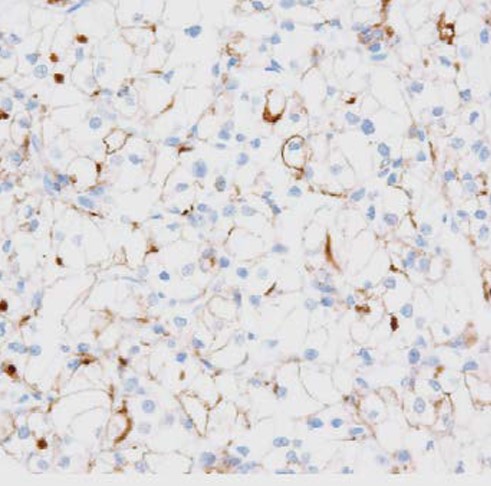Anti-TIM-3 Antibody (34073)
$308.00
Overview
Product Name Anti-TIM-3 Antibody (34073)
Description Anti-TIM3 Mouse Monoclonal Antibody
Target TIM-3
Species Reactivity Human
Applications IHC
Host Mouse
Clonality Monoclonal
Clone ID G003.1
Isotype IgG1
Immunogen Recombinant human TIM-3.
Properties
Form Liquid
Concentration Lot Specific
Formulation Tris buffer, pH 7.3-7.7, 1% BSA, 0.1% sodium azide.
Buffer Formulation Tris
Buffer pH pH 7.3-7.7
Buffer Anti-Microbial 0.1% Sodium Azide
Buffer Protein Stabilizer 1% Bovine Serum Albumin
Format Purified
Purification Purified by immunoaffinity chromatography
Specificity Information
Specificity Human TIM-3. Reactivity with other species has not been investigated.
Target Name Hepatitis A virus cellular receptor 2
Target ID TIM-3
Uniprot ID Q8TDQ0
Alternative Names HAVcr-2, T-cell immunoglobulin and mucin domain-containing protein 3, TIMD-3, T-cell immunoglobulin mucin receptor 3, TIM-3, T-cell membrane protein 3, CD antigen CD366
Gene Name HAVCR2
Sequence Location Membrane, Cell junction, Cell membrane
Biological Function Cell surface receptor implicated in modulating innate and adaptive immune responses. Generally accepted to have an inhibiting function. Reports on stimulating functions suggest that the activity may be influenced by the cellular context and/or the respective ligand (PubMed:24825777). Regulates macrophage activation (PubMed:11823861). Inhibits T-helper type 1 lymphocyte (Th1)-mediated auto- and alloimmune responses and promotes immunological tolerance (PubMed:14556005). In CD8+ cells attenuates TCR-induced signaling, specifically by blocking NF-kappaB and NFAT promoter activities resulting in the loss of IL-2 secretion. The function may implicate its association with LCK proposed to impair phosphorylation of TCR subunits, and/or LGALS9-dependent recruitment of PTPRC to the immunological synapse (PubMed:24337741, PubMed:26492563). In contrast, shown to activate TCR-induced signaling in T-cells probably implicating ZAP70, LCP2, LCK and FYN (By similarity). Expressed on Treg cells can inhibit Th17 cell responses (PubMed:24838857). Receptor for LGALS9 (PubMed:16286920, PubMed:24337741). Binding to LGALS9 is believed to result in suppression of T-cell responses; the resulting apoptosis of antigen-specific cells may implicate HAVCR2 phosphorylation and disruption of its association with BAG6. Binding to LGALS9 is proposed to be involved in innate immune response to intracellular pathogens. Expressed on Th1 cells interacts with LGALS9 expressed on Mycobacterium tuberculosis-infected macrophages to stimulate antibactericidal activity including IL-1 beta secretion and to restrict intracellular bacterial growth (By similarity). However, the function as receptor for LGALS9 has been challenged (PubMed:23555261). Also reported to enhance CD8+ T-cell responses to an acute infection such as by Listeria monocytogenes (By similarity). Receptor for phosphatidylserine (PtSer); PtSer-binding is calcium-dependent. May rUniProtKB:Q8VIM0, PubMed:11823861, PubMed:14556005, PubMed:16286920, PubMed:22323453, PubMed:23555261, PubMed:24838857, PubMed:26492563, PubMed:30374066, PubMed:24825777}.
Research Areas Cancer research
Background T cell immunoglobulin and mucin domain-3 (TIM-3) is a member of the TIM gene family, which includes TIM-1, TIM-3, TIM-4 in humans and Tim-1-8 in mice. TIM-3 is expressed on Th1, Th17, and CD8+ T cells as well as on dendritic cells and natural killer cells. Binding of TIM-3 and its ligands has been found to suppress Th1 and Th17 responses and induce peripheral immune tolerance, supporting an inhibitory role of TIM-3 in T cell-mediated immune responses. TIM-3 expression also characterizes exhausted T cells during chronic infection. Since administration of TIM-3 and PD-1 mAbs synergistically control tumor growth, TIM-3 is gaining importance in tumor and chronic viral infection models as a candidate for immunotherapy in conjunction with other inhibitory receptors.
Application Images


Description Immunohistochemistry: use at a dilution of 1:100-1:200 on formalin-fixed, paraffin-embedded samples after heat-induced epitope retrieval at pH 9 for 10-30 minutes. Detection of TIM-3 in human kidney with #34073 diluted 1:100-1:200.
Handling
Storage Store at 2-8°C. Do not freeze.
Dilution Instructions Dilute in PBS or medium that is identical to that used in the assay system.
Application Instructions
Immunohistochemistry: use at a dilution of 1:100-1:200 on formalin-fixed, paraffin-embedded samples after heat-induced epitope retrieval at pH 9 for 10-30 minutes.
Immunohistochemistry: use at a dilution of 1:100-1:200 on formalin-fixed, paraffin-embedded samples after heat-induced epitope retrieval at pH 9 for 10-30 minutes.
References & Data Sheet
Data Sheet  Download PDF Data Sheet
Download PDF Data Sheet
 Download PDF Data Sheet
Download PDF Data Sheet


